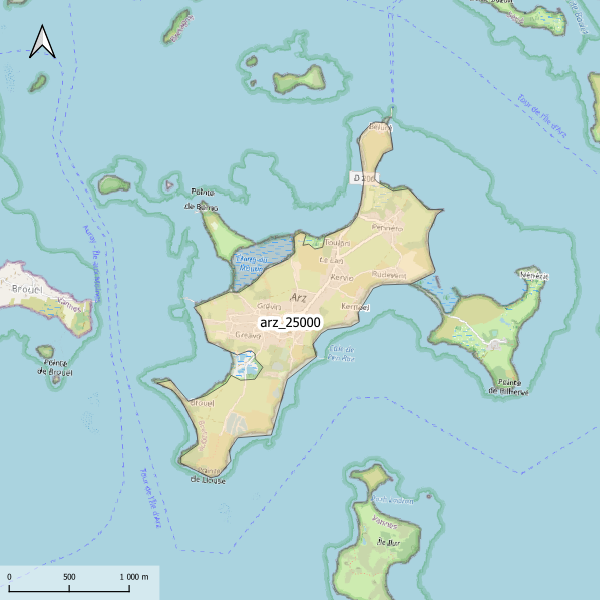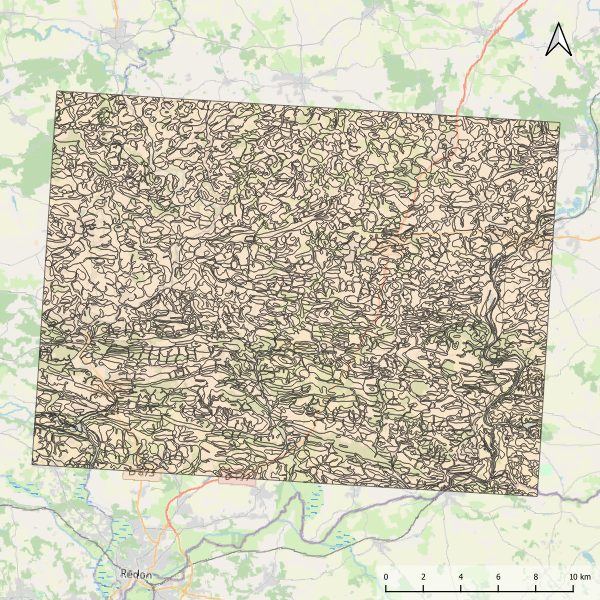asNeeded
GEMET keywords
Type of resources
Available actions
Topics
INSPIRE themes
Keywords
Contact for the resource
Provided by
Years
Formats
Representation types
Update frequencies
status
Scale
Resolution
-

Emprise de la carte pédologique de l'île d'Arz au 1/25000. La donnée de base, au format image scannée, n'est pas publiée.
-

Occupation des sols 2019 du bassin versant du site de Naizin dans le Morbihan dans le cadre de l'Observatoire de Recherche en Environnement (ORE) AgrHyS d'INRAE. Le parcellaire est issu du cadastre de 2013. Les dessertes ont été redessinées à partir des orthophotos IGN de 2013 et le parcellaire a été découpé en fonction d’une zone tampon autour de ces dessertes. Les parcelles 2013 peuvent être découpées mais jamais regroupées. Toutes les entités géographiques élémentaires ont un identifiant unique sur l’ensemble des années. Champs de la table d’attribut : • ID_2019 : identifiant de la parcelle pour l’année 2019 • TYPE_19 : code principal de l’occupation des sols • S_TYPE_19 : code secondaire de l’occupation des sols • ID_PARCEL : Identifiant numérique et non significatif par parcelle du RPG 2019 • CODE_GROUP : code du groupe de cultures du RPG 2019 • CODE_CULTU : code du groupe de cultures majoritaire du RPG 2019 • CULTURE_D1 : code de la culture dérobée (culture intercalée entre 2 moissons de culture principale) sur la parcelle. • CULTURE_D2 : code de la seconde culture dérobée (culture intercalée entre 2 moissons de culture principale). La nomenclature de ces codes des types et sous-types a été définie dans le programme ANR-12-AGRO-0005 MOSAIC : https://anr.fr/Projet-ANR-12-AGRO-0005. Leurs descriptions peuvent être télécharger ici : https://geosas.fr/metadata/ore/xls/legendes_osol_naizin.xlsx. Les occupations des sols sont issues des données par parcelles du Registre Parcellaire Graphique (RPG) de l’année 2019. Les limites des parcelles ont été mises en concordance avec le parcellaire de 2013.
-

Occupation des sols 1993 du bassin versant du site de Naizin dans le Morbihan dans le cadre de l'Observatoire de Recherche en Environnement (ORE) AgrHyS d'INRAE. Le parcellaire est issu du cadastre de 2013. Les dessertes ont été redessinées à partir des orthophotos IGN de 2013 et le parcellaire a été découpé en fonction d’une zone tampon autour de ces dessertes. Les parcelles 2013 peuvent être découpées mais jamais regroupées. Toutes les entités géographiques élémentaires ont un identifiant unique sur l’ensemble des années. Champs de la table d’attribut : • ID_1993 : identifiant de la parcelle pour l’année 1993 • TYPE : code principal de l’occupation des sols • S_TYPE : code secondaire de l’occupation des sols La nomenclature de ces codes des types et sous-types a été définie dans le programme ANR-12-AGRO-0005 MOSAIC : https://anr.fr/Projet-ANR-12-AGRO-0005. Leurs descriptions peuvent être télécharger ici : https://geosas.fr/metadata/ore/xls/legendes_osol_naizin.xlsx. Les occupations des sols sont issues de photo-interprétation dans le cadre du programme CORMORAN (Cheverry et al., 1998). Les limites des parcelles ont été mises en concordance avec le parcellaire de 2013.
-

Occupation des sols 2006 du bassin versant du site de Naizin dans le Morbihan dans le cadre de l'Observatoire de Recherche en Environnement (ORE) AgrHyS d'INRAE. Le parcellaire est issu du cadastre de 2013. Les dessertes ont été redessinées à partir des orthophotos IGN de 2013 et le parcellaire a été découpé en fonction d’une zone tampon autour de ces dessertes. Les parcelles 2013 peuvent être découpées mais jamais regroupées. Toutes les entités géographiques élémentaires ont un identifiant unique sur l’ensemble des années. Champs de la table d’attribut : • ID_2006 : identifiant de la parcelle pour l’année 2006 • TYPE_06 : code principal de l’occupation des sols • S_TYPE_06 : code secondaire de l’occupation des sols • ID_ILOT : Identifiant numérique et non significatif par îlot du RPG 2006 • CODE_GROUP : code du groupe de cultures du RPG 2006 La nomenclature de ces codes des types et sous-types a été définie dans le programme ANR-12-AGRO-0005 MOSAIC : https://anr.fr/Projet-ANR-12-AGRO-0005. Leurs descriptions peuvent être télécharger ici : https://geosas.fr/metadata/ore/xls/legendes_osol_naizin.xlsx. Les occupations des sols sont issues des données par ilot du Registre Parcellaire Graphique (RPG) de l’année 2006. Les limites des parcelles ont été mises en concordance avec le parcellaire de 2013.
-

Map of existing and lost wetlands of the Couesnon watershed, derived from a Sentinel-1 and 2 time-series classification. Natural vegetations classes (C3.1, C3.2, D1.1, E3.41, G1.2, I1.1 and J EUNIS classes) were assigned to existing wetlands whereas other land cover classes (C, I1.1, J) were reclassified as lost wetlands.
-

Représentation du réseau hydrographique sur la zone d'étude INRA de Naizin.
-

Carte pédologique de Pipriac au 1/25000. La codification correspond au code 4 critères des sols du Massif armoricain (voir ressources en ligne). Les champs de la table attributaire sont : - SUB : Matériau(x) parental(aux) à partir du(des)quel(s) se développe(nt) le sol - HYD : Classe d'hydromorphie, de 0 (sol bien drainé) à 9 (sol extrêmement hydromorphie) - TYPE : Développement de profil défini à partir de la succession des horizons - PROF : Profondeur du sol, classée de 1 (sols très épais) à 6 (sols superficiels) - CODE4C : code 4 critères issu de la concaténation des champs précédents. Les valeurs prises par les différents champs pour chaque entité sont détaillées dans la méthode 4 critères (voir ressources en ligne). - UTS : Numéro d'Unité Typologique de Sol issue du Référentiel Régional Pédologique de Bretagne.
-

Occupation du sol du site de Pleine-Fougères en 2010 (Zone Atelier Armorique) réalisée à partir de la photointerprétation de vol ULM
-

Occupation des sols 2013 du bassin versant du site de Naizin dans le Morbihan dans le cadre de l'Observatoire de Recherche en Environnement (ORE) AgrHyS d'INRAE. Le parcellaire est issu du cadastre de 2013. Les dessertes ont été redessinées à partir des orthophotos IGN de 2013 et le parcellaire a été découpé en fonction d’une zone tampon autour de ces dessertes. Les parcelles 2013 peuvent être découpées mais jamais regroupées. Toutes les entités géographiques élémentaires ont un identifiant unique sur l’ensemble des années. Champs de la table d’attribut : • ID_2013 : identifiant de la parcelle pour l’année 2013 • TYPE_13 : code principal de l’occupation des sols • S_TYPE_13 : code secondaire de l’occupation des sols • NUM_ILOT : Identifiant numérique et non significatif par îlot du RPG 2013 • CODE_GROUP : code du groupe de cultures du RPG 2013 • CODE_CULTU : code du groupe de cultures majoritaire du RPG 2013 La nomenclature de ces codes des types et sous-types a été définie dans le programme ANR-12-AGRO-0005 MOSAIC : https://anr.fr/Projet-ANR-12-AGRO-0005. Leurs descriptions peuvent être télécharger ici : https://geosas.fr/metadata/ore/xls/legendes_osol_naizin.xlsx. Les occupations des sols sont issues de l’enquête auprès des agriculteurs dans le cadre du programme ANR-12-AGRO-0005 MOSAIC. Une parcelle d’usage est définie comme l’association d’une culture et d’un exploitant. Les parcelles sans information d’occupation des sols ont été renseignées soit avec le RPG 2013 (parcelles agricoles sans enquêtes) soit avec les orthophotos IGN de 2013 (forêts, zones urbanisées…).
-
Échantillonnage de gaz émis par les sols de prairies permanentes drainées ou non au sein de la Zone Atelier Armorique (ZAAr) et analyses des Composés Organiques Volatils (COVs - spectres de masses et flux) et flux de CO2. Données pédoclimatiques associées.
 OSURIS
OSURIS